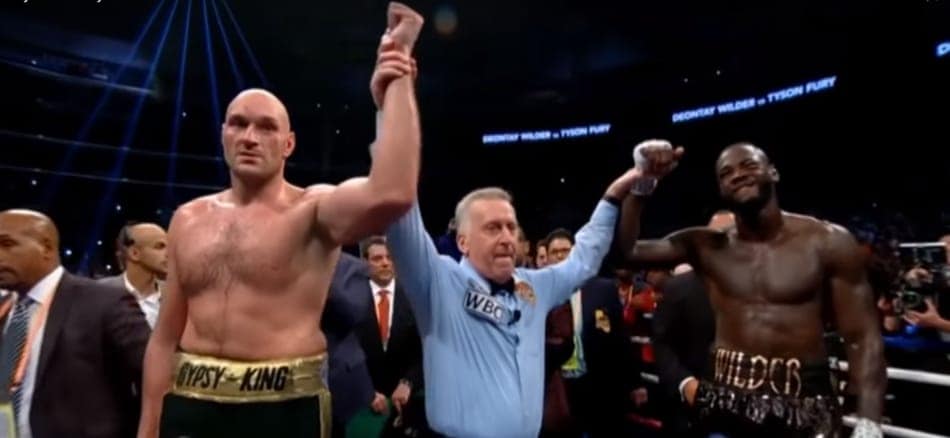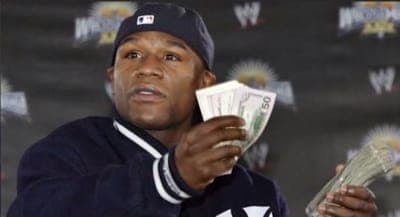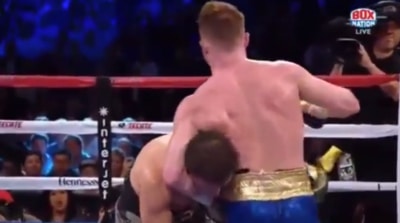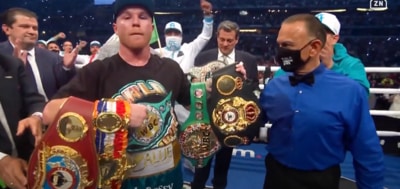
The heavyweight division is the most prestigious in boxing because it features the largest and hardest-hitting athletes in the sport. But with so many heavyweight titles up for grabs, how can you tell who the real champion is? Which championship belt is the most important?
The four major belts in this division are the WBA, WBC, WBO, and IBF heavyweight titles. There are more, but these four are typically used to identify the best fighter in the weight class. While some belts are more treasured than others, there isn’t a single official title that holds more value than the rest.
Champions rarely hold all four titles at the same time, though. As such, it can be quite difficult to determine the cream of the heavyweight crop. In order to get a sense of how this all works, we need to go back to the very beginning.
History of the heavyweight division
- World Boxing Association (WBA) – founded 1921
- The Ring world championship belt – 1922
- World Boxing Council (WBC) – founded 1963
- International Boxing Federation (IBF) – founded 1983
- World Boxing Organization (WBO) – founded 1988
*More info on the organizations here.
If we consider the adoption of the Marquess of Queensberry rules as the birth of professional boxing, then the first heavyweight champion was John L. Sullivan. He earned that title by defeating Jim Corbett in 1892. Back then, many heavyweight fighters weighed around 170-200 pounds.
In 1920, the light heavyweight division was established with a maximum weight of 175 pounds. Any fighter who surpassed that limit was a heavyweight. But with the creation of the 190-pound cruiserweight division in 1979, the heavyweight requirements were changed. When the upper limit for cruiserweights was later increased to 200 pounds, it was decided that any fighter who weighed more than that was a heavyweight.
That standard remains in three of the four major boxing organizations. The WBC recently added a new division called bridgerweight with an upper weight limit of 224 pounds. Consequently, any fighter who surpasses that mark is considered a heavyweight. The bridgwerweight title is currently vacant.
In theory, a bridgerweight in the WBC could be perceived as a heavyweight by other organizations. This only muddies a landscape that already contains so many belts.
Why are there so many titles in one division anyway?
Sanctioning bodies
As we recently discussed, money is the main reason behind the abundance of belts. Organizations charge a fee for sanctioning title fights and also claim a percentage of the purse for both the champion and challenger (typically around 3%).
These sanctioning bodies have a clear financial incentive for introducing more championship belts and thus booking more title fights.
It wasn’t always like this, of course. At first, the lineal champion was the only legitimate champion. In order to gain this title, a fighter had to defeat the reigning champion. To be the man, you had to beat the man. It was simple and there were no heated debates surrounding the legitimacy of their championship like there are today.
This all changed with the creation of the first official sanctioning body in 1962 when the National Boxing Association became the World Boxing Association (WBA). Though it was accepted as a proper organization, it faced several problems. The two main issues were that its “world” title fights often only featured American boxers and many contests were fixed by the mob. This obviously called into question the fairness and integrity of the fights.
One year later, 11 countries launched the World Boxing Council (WBC) in an attempt to rectify the WBA’s mistakes:
- United States (and Puerto Rico)
- Argentina
- United Kingdom
- France
- Mexico
- The Philippines
- Panama
- Chile
- Peru
- Venezuela
- Brazil
Unsurprisingly, it ran into the same pitfalls that the WBC did. Nevertheless, these two sanctioning bodies ran the boxing world throughout the ‘60s and ‘70s.
A third organization emerged in the early ‘80s after United States Boxing Association president Robert Lee failed in his bid to become president of the WBA. He bounced back by creating the International Boxing Federation (IBF). Once again, there were serious issues that damaged the legitimacy of the organization. Lee faced several criminal charges and was convicted of money laundering and tax evasion in 2000.
Finally, there is the World Boxing Organization (WBO). It started when Puerto Rican and Dominican representatives left the WBA’s 1988 convention because of a disagreement regarding the application of certain rules.
Each of these organizations has its own heavyweight title.
Heavyweight belts
With these four major sanctioning bodies in place, their championship belts became the most sought-after in the sport. If you do not hold at least one of the WBA, WBC, WBO or IBF titles, you are not seen as a legitimate champion.
A fighter who holds more than one of these belts is called the unified champion. A fighter who holds all four major titles is called the undisputed champion.
As we mentioned earlier, though, this is an incredibly rare occurrence in this weight class for a couple of reasons.
Firstly, we must consider the very nature of the heavyweight division. Given the size and power of these fighters, just one shot can change the course of a fight. Holding your title long enough to obtain the other three is a tall order. Secondly, there is the sport’s politics. Especially in modern boxing, promoters want to protect their fighters by making them earn money while limiting risk as much as possible. That is why the best fights frequently do not materialize.
Since the start of the WBA era, there have been 12 undisputed heavyweight champions:
- Sonny Liston (1963)
- Muhammad Ali (1964)
- Muhammad Ali (1967)
- Joe Frazier (1970)
- George Foreman (1973)
- Muhammad Ali (1974)
- Leon Spinks (1978)
- Mike Tyson (1987)
- Buster Douglas (1990)
- Evander Holyfield (1990)
- Riddick Bowe (1992)
- Lennox Lewis (2000)
However, none of these fighters held all four of the WBA, WBC, WBO, and IBF titles at once. Wladimir Klitschko, Andy Ruiz, Tyson Fury, and Anthony Joshua came closest by holding the WBA, WBO, and IBF belts. By recently defeating Joshua at heavyweight, Oleksandr Usyk now holds those three titles.
There are other, less meaningful belts as well. The WBC introduced a Diamond belt in 2009. According to the organization, “The belt was originally created as an honorary championship exclusively to award the winner of a historic fight between two high-profile and elite boxers.” It was recently up for grabs in a 2020 bout between Dillian Whyte and Alexander Povetkin.
However, it is little more than a way for the WBC to inject itself into fights it is not otherwise involved in. In other words, it is yet another way for the WBC to make money.
The WBC has another honorary title called the Eternal World Heavyweight Championship. Vitali Klitschko earned this label in 2016 on the strength of a stellar career.
Current heavyweight landscape
As it stands, Tyson Fury (30-0-1) holds the WBC heavyweight title and Oleksandr Usyk (19-0-0) holds the WBA, WBO, and IBF titles. Let’s take a look at how they got there.
Wladimir Klitschko was the WBA, WBO, and IBF heavyweight champion in 2015. Fury defeated him by unanimous decision and therefore became a unified champion. Klitschko also happened to be the lineal champion, so Fury earned that title too.
Unfortunately, Fury hit rock bottom following this lofty accomplishment. Ahead of a rematch against Klitschko, he suffered from extreme weight gain, substance abuse, and depression. Deeming himself unfit to defend his titles, Fury vacated them in 2016. Following a series of fights against different opponents, Anthony Joshua claimed Fury’s three titles.
Meanwhile, Fury began his comeback in 2018.
He challenged Deontay Wilder for the WBC heavyweight title, but the fight ended in a draw. In early 2020, the pair faced off once again. This time, Fury won the WBC title by technical knockout in the seventh round when Wilder’s corner threw in the towel. Fury and Wilder will meet once again in an October 9 rubber match.
On the other side of the equation, Usyk was an undefeated cruiserweight who decided to step up for a challenge in the heavyweight ranks.
After defeating Chazz Witherspoon by technical decision and Derek Chisora by unanimous decision, he landed a high-profile fight against Joshua in September 2021. Usyk snatched the WBA, WBO, and IBF titles that Fury had relinquished by overwhelming Joshua with his pace and footwork. The southpaw just kept coming at his opponent and ultimately proved too much to handle, winning by unanimous decision.
So after being an undisputed champion at cruiserweight, he is now a unified champion at heavyweight. That is a remarkable feat.
If a fight ever materializes between Usyk and the WBC champion—whether that’s Fury or Wilder—boxing immortality will be there for the taking: all four major titles and the status of a lineal champion.
At that point, no matter who prevails, there will be no room for debate. The winner will be the legitimate undisputed heavyweight champion of the world.
Conclusion
There are four major heavyweight belts: the WBA, WBC, WBO and IBF titles. If you hold any of those, you are in the conversation as the best heavyweight fighter in the sport. If you own more than one, you strengthen your case by being a unified champion. And if you claim all four, you are the undisputed champion. There has not been an undisputed heavyweight champion since Lennox Lewis in 2000.
Part of that stems from the Klitschko brothers’ refusal to fight each other. Vitali held the WBC title from 2004-2012 before retiring, whereas Wladimir held multiple major titles from 2006-2017 before his own retirement.
Moreover, promoters usually play it safe with their fighters, opting to line their pockets through easy bouts instead of high-risk, high-reward championship fights.
Thankfully, Usyk appears ready to take on all comers. With the title of undisputed champion one fight away, we may soon witness the most important heavyweight tilt in quite some time.



